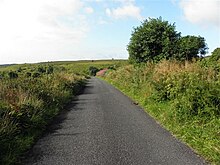Altachullion Upper
Coordinates: 54°09′17″N 7°46′48″W / 54.1546°N 7.7800°W

Altachullion Upper (from Irish: Alt an Chuilinn Uachtarach, meaning The Upper Glen of the Holly) is a townland in the civil parish of Templeport, County Cavan, Ireland. It lies in the Roman Catholic parish of Corlough and barony of Tullyhaw.[1] A sub-division is called The Tebente - a name given to a field which in 1938 was the property of Mrs McGoldrick.

Geography[]
Altachullion Upper is bounded on the north by Altachullion Lower townland, on the south by Altateskin townland, on the west by Legnaderk and Altnadarragh townlands and on the east by Altinure, Tullyloughfin and Tullynamoltra townlands. Its chief geographical features are mountain streams, gravel pits, springs and dug wells. Altachullion Upper is traversed by minor public roads and rural lanes. The townland covers 271 statute acres,.[2]
History[]
In earlier times the townland was probably uninhabited as it consists mainly of bog and poor clay soils. It was not seized by the English during the Plantation of Ulster in 1610 or in the Cromwellian Settlement of the 1660s so some dispossessed Irish families moved there and began to clear and farm the land.
The earliest reference to the townland is on a map dated 1813 where it is called ‘’Altaghullen’’.
In the 19th century the landlord was Lord John Beresford, the Protestant Archbishop of Armagh. The muddled land history of the area prior to this is described in the 1838 Exchequer case, "Attorney General of Ireland v The Lord Primate".[3] The maps used in the case are viewable online at- [9]
The Tithe Applotment Books for 1826 list twelve tithepayers in the townland.[4]
The Ordnance Survey Name Books for 1836 give the following description of the townland- It is bounded on the north side by a large stream which rises in the mountain and runs towards the southeast. ...a flax kiln.
The Altachullion Upper Valuation Office Field books are available for August 1839.[5][6]
In 1841 the population of the townland was 48, being 28 males and 20 females. There were nine houses in the townland, all of which were inhabited.[7]
In 1851 the population of the townland was 50, being 30 males and 20 females. There were five houses in the townland and all were inhabited. [8]
Griffith's Valuation of 1857 lists seven landholders in the townland.[9]
In 1861 the population of the townland was 32, being 18 males and 14 females. There were six houses in the townland and all were inhabited.[10]
In 1871 the population of the townland was 53, being 27 males and 26 females. There were eight houses in the townland, all were inhabited.[11]
In 1881 the population of the townland was 33, being 13 males and 20 females. There were seven houses in the townland, all were inhabited.[12]
In 1891 the population of the townland was 40, being 17 males and 23 females. There were seven houses in the townland, all were inhabited.[13]
In the , there are seven families listed in the townland.[14]
In the 1911 census of Ireland, there are seven families listed in the townland.[15]
Antiquities[]
The only structure of historical interest in the townland is
- A footbridge over the stream
References[]
- ^ "Placenames Database of Ireland". Retrieved 29 February 2012.
- ^ "IreAtlas". Retrieved 29 February 2012.
- ^ Jebb, Robert; Symes, Arthur R. (1840). "Reports of Cases Argued and Determined in the Courts of Queen's Bench and Exchequer Chamber in Ireland: With Tables of the Names of the Cases and the Principal Matters". Missing
|author1=(help) - ^ [1] and [2]Tithe Applotment Books 1826
- ^ [3]
- ^ [4]
- ^ "Accounts and Papers of the House of Commons". 1853.
- ^ "Accounts and Papers of the House of Commons". 1853.
- ^ [5] - Griffith's Valuation
- ^ The census of Ireland for the year 1861. Printed by A. Thom for H.M. Stationery Off.
- ^ "Census of Ireland 1871 : Part I, Area, Population, and Number of Houses; Occupations, Religion and Education volume III, Province of Ulster; Summary Tables, Indexes". 1874.
- ^ "Census of Ireland 1881 : Area, Population and Number of Houses; Occupations, Religion and Education volume III, Province of Ulster". 1882.
- ^ [6]
- ^ [7]Census of Ireland 1901
- ^ [8]Census of Ireland 1911
External links[]
- Townlands of County Cavan

